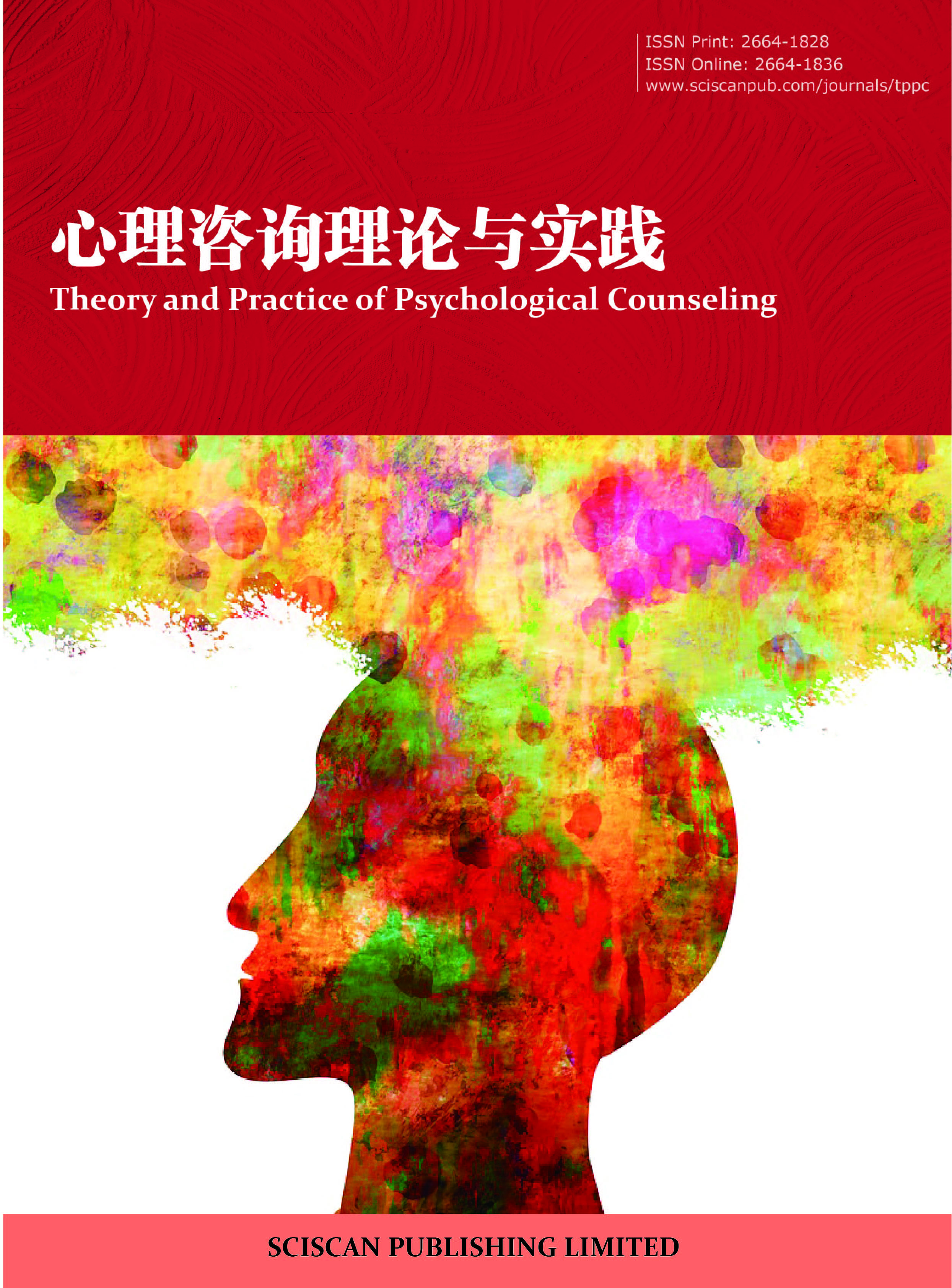Theory and Practice of Psychological Counseling
医学生神经衰弱调查及与生活事件、个性特征相关研究
Neurasthenia Survey of Medical Students and Study Their Life Events, Characteristics of the Relevant
- Authors: 郑欣¹² 王书哲² 毛富强²
-
Information:
1.天津市安定医院,天津; 2.天津医科大学精神卫生与心理学系,天津
-
Keywords:
College students; Neurasthenia; Inventory survey; Life events医学生; 神经衰弱; 现状调查; 生活事件
- Abstract: Objective: On the status of college students’ neurasthenia investigates and further explore its relationship with the relevance of psychosocial factors. Methods: A random sampling method, taking the whole school of 246 students, including 144 boys, 102 girls, with the CCMD-3 diagnostic criteria for neurasthenia their diagnosis, to meet the diagnostic criteria of college students as the study group, did not meet diagnostic criteria for students As a control group, and then life events scale (ASLEC) and the Eysenck Personality Questionnaire (EPQ) to investigate. SPSS11.5 software to analyze the results. Results: In the 246 students surveyed, a total of 39 people sick, the prevalence was 15.9%, of which 24 were boys and the number of patients, the prevalence was 16.6%, female prevalence at 15, the prevalence was 14.7%. Study group in the number of adverse life events should be more than the control group, the difference was significant (p<0.05). Description adverse life events and the incidence of neurasthenia is closely related to psychosocial factors in the pathogenesis of neurasthenia occupy a certain position. Eysenck Personality Questionnaire survey by the study group N neuroticism scores than the control group, often, the difference was statistically significant (p<0.05), including the dumping or extraversion scores than the control group, the difference with sex (p<0.05). Conclusions: Students currently neurasthenia in a higher prevalence, reaching 15.9%. Studies have shown that psychosocial factors with correlation with nervous breakdown of the students experienced more than the normal adverse life events; in the Eysenck personality questionnaire, the prevalence on college students scored higher in neuroticism, introversion or lower extraversion scores, show their personality traits have higher neuroticism and introversion. 目的:对当代医学生神经衰弱现状进行调查,并进一步地探讨其与心理社会因素的相关性。方法:采取随机取样法,抽取全校246名医学生,其中男生144 人,女生102人,用CCMD-3神经衰弱的诊断标准对其进行诊断,把符合诊断标准的医学生作为研究组,没有达到诊断标准的医学生作为对照组,然后用青少年生活事件量表(ASLEC)和艾森克人格问卷(EPQ)进行调查。结果采取SPSS11.5软件进行分析。结果:在被调查的246名医学生中,共有39人患病,患病率为15.9%,其中男生患病人数为24人,患病率为16.6%,女生患病人数为15人,患病率为14.7%。研究组在不良生活事件数量比对照组要多,差异有显著性(p<0.05)。说明不良生活事件与神经衰弱的发病有密切关系,在神经衰弱的发病中占有一定地位。通过艾森克人格问卷调查发现研究组在N 神经质的得分高于常对照组,差异有显著性(p<0.05),在内倾性或外倾性的得分比对照组低,差异有显著性(p<0.05)。结论:目前神经衰弱在医学生的发病率较高,达15.9%。研究显示它与生活事件有相关性,患有神经神经衰弱的医学生比正常人经历过更多的不良生活事件;在艾森克人格问卷调查中,患病医学生在神经质上得分较高,内倾性或外倾性得分较低,显示他们的个性特征有较高的神经质和内倾性。
- DOI: https://doi.org/10.35534/tppc.0503019
- Cite: 郑欣,王书哲,毛富强.医学生神经衰弱调查及与生活事件、个性特征相关研究[J].心理咨询理论与实践,2023,5(3):199-211.
1 前言
神经衰弱(neurasthenia)是一种发病机制尚未清楚的疾病,它是一种以脑和躯体功能衰弱为主的神经症,以精神易兴奋却又易疲劳为特征,常有紧张、烦恼、易激惹和睡眠功能障碍等生理功能紊乱症状。这些症状不能归因于躯体疾病、脑器质性病变或其他精神疾病,但病前可存在持久的情绪紧张和精神压力。
神经衰弱的概念在这一百多年中经历了一系列变迁,在美国和西欧,本病的诊断由盛而衰,终至于消失。在东亚,本病仍然继续被诊断。其原因除社会文化因素对患病率的影响之外,更主要的是医生对神经衰弱这一疾病的认识发生变化。在过去这一疾病的名称包括的范围过宽。其后,随着各种特殊综合症的分出,使这一疾病概念迅速缩小。又由于神经衰弱的症状缺乏特异性,几乎都可见于其他神经症,如焦虑症、抑郁性神经症、疑病症、躯体化障碍等,使本病的诊断更加困难。我国精神病学基于长期的临床实践,制订了较明确的神经症诊断标准,使神经衰弱的临床诊断规范化;调查结果表明,本病仍然是最常见的神经症。1982年我国12地区精神疾病流行学调查,在15~59岁居民中,神经衰弱的患病率为13.3%,占全部神经症病例的58.7%,居各种神经症的首位。天津市区(1981—1982)调查,本病的患病率为9.1%,占神经症全部病例的68.0%。女性患病率显著高于男性,起病年龄大多在青壮年时期,以15~39岁较多见。国外,本病已不作诊断,而把它归属其他神经症性障碍中,所以这方面资料缺如[10]。
从神经衰弱的概念被提出以来,就一直被看作是可由素质、躯体、心理社会和环境等诸多因素引起的一种疾病。其中,心理社会因素在神经衰弱的发病机制中占有重要地位,长期的心理冲突和精神创伤引起的负性情绪体验是本病一种较多见的原因。学习和工作不适应,家庭纠纷、婚姻恋爱问题处理不当,以及人际关系紧张,引起患者思想上矛盾和内心冲突,导致长期的悲伤、痛苦等负性情感体验,以致神经衰弱的产生。再者,人格特征在神经衰弱的发病中也起到一定作用。研究发现患有神经衰弱的病人往往有较高的神经质倾向,而且大多偏向于内向型人格。
2 研究方法
2.1 研究对象
本研究采用了随机取样的方法,抽取天津医科大学五个年级不同专业班级的学生完成调查和量表,被试的总数为247名,其中一名被试遗失,有效数据为246份,男生144人,女生102人,男女比为1.4∶1。其中大一40人(16.2%),大二47人(19.1%),大三52人(21.1%),大四56人(22.7%),大五51人(20.7%)。来自城市的有112人,来自乡镇的有134人,比例约为4∶5。平均年龄21.61±1.65岁。
2.2 材料
(1)研究对象的基本情况:性别、年龄、年级、生源所在地。
(2)CCMD-3神经衰弱诊断标准:CCMD-3是目前国内使用较广泛的一种精神疾病的诊断标准,其对神经衰弱的诊断如下:症状标准:第一,符合神经症的诊断标准;第二,以脑和躯体功能衰弱症状为主,特征是持续和令人苦恼的脑力易疲劳(如感到没有精神,自感脑子迟钝,注意力不集中或不持久,记忆力差,思考效率下降)和体力易疲劳,经过休息或娱乐不能恢复,并至少有下列2项:①情感症状,如烦恼、心情紧张、易激惹等,常与现实生活中的各种矛盾有关,感到困难重重,难以应付;②兴奋症状,如感到精神易兴奋(如回忆和联想增多,主要是对指向性思维感到费力,而非指向性思维却很活跃,因难以控制而感到痛苦和不快),但无言语运动增多。有时对声光很敏感;③肌肉紧张性疼痛(如紧张性头痛、肢体肌肉酸痛)或头晕;④睡眠障碍,如入睡困难、多梦、醒后感到不解乏,睡眠感丧失,睡眠觉醒节律紊乱;⑤其他心理生理障碍,如头晕眼花、耳鸣、心慌、胸闷、腹胀等。严重标准:病人因明显感到脑和躯体功能衰弱,影响其社会功能,为此感到痛苦或主动求治。病程标准:符合症状标准至少已3个月。排除标准:第一,排除以上任何一种神经症亚型;第二,排除分裂症、抑郁症。
(3)青少年生活事件量表(ASLES):该量表由刘贤臣等编制,适应于对青少年尤其是中学生和大学生应激性生活事件发生频度和应激强度进行评定。ASLEC为一自评量表,有27项可能给青少年带来心理反应的负性生活事件构成。评定期限依据研究目的而定,可为最近3个月、6个月、9个月或12个月。对每个事件的回答方式应先确定该事件在限定时间内发生与否,若为发生过仅在未发生栏目内划“√”,若发生过则根据事件发生时的心理感受分为五级评定,即无影响(一级)、轻度(二级)、中度(三级)、重度(四级)或极重度(五级)。
(4)艾森克人格问卷(EPQ):是由H.J.艾森克和S.B.G.艾森克设计的一种有关人格维度研究的测定方法。简称EPQ。通用的EPQ是1975年制定的,它是一种自陈量表,有成人和少年两种形式,各包括4个量表:E——内外向;N——神经质,又称情绪性;P——精神质,又称倔强、讲求实际;L——谎造或自身隐 。经艾森克等人的因素分析计算,前3个量表代表人格结构的3种维度,它们是彼此独立的,L 则是效度量表,代表假托的人格特质,也表现社会性、幼稚的水平。L 虽与其他量表有某些相关,但它本身却代表一种稳定的人格功能。由于EPQ具有较高的信度和效度,用其所测得的结果可同时得到多种实验心理学研究的印证,因此它也是验证人格维度理论的根据。
2.3 程序
在施测的过程中,采用随机取样的方法抽取被试。由主试首先向学生说明主导语,学生理解答题要求之后,一次性完成CCMD-3的诊断量表、青少年生活事件量表、艾森克人格问卷量表。在对全部数据行审核的基础上,共获取有效数据246份。全部数据采用SPSS11.5 For Windows统计软件包进行处理,统计方法为卡方检验、相关分析和单因素方差分析。
3 研究结果与分析
3.1 医学生神经衰弱的患病情况
以年级为自变量对医学生神经衰弱的患病情况进行调查。结果见表1。表1说明大一年级的患病率最高,达22.5%,其次是大五年级,达21.5%;大三年级患病率最低,只有9.6%。
表 1 不同年级医学生神经衰弱患病情况
Table 1 Incidence of neurasthenia among medical students of different grades
|
年级 |
调查人数 |
患病人数 |
患病率 |
|
大一 |
40 |
9 |
22.5% |
|
大二 |
47 |
8 |
17.0% |
|
大三 |
52 |
5 |
9.6% |
|
大四 |
56 |
6 |
10.7% |
|
大四 |
51 |
11 |
21.5% |
以性别为自变量对医学生神经衰弱的患病情况进行调查。结果见表2。表2说明男性患病率高于女性。
表 2 不同性别医学生神经衰弱患病情况
Table 2 Incidence of neurasthenia among medical students of different genders
|
性别 |
调查人数 |
患病人数 |
患病率 |
|
男生 |
144 |
24 |
16.6% |
|
女生 |
104 |
15 |
14.7% |
以生源地为自变量对医学生神经衰弱的患病情况进行调查。结果见表3。表3说明农村生源的医学生患病率稍高于城市生源。
表 3 不同生源地医学生神经衰弱患病情况
Table 3 Incidence of neurasthenia among medical students from different places of origin
|
生源地 |
调查人数 |
患病人数 |
患病率 |
|
农村 |
134 |
23 |
16.9% |
|
城市 |
112 |
16 |
14.2% |
以院系为自变量对医学生神经衰弱的患病情况进行调查。结果见表4。表4说明在学校不同院系间,临床医学院的患病率最高,达22.2%;基础医学院的患病率为最低,为11.5%。
表 4 不同院系医学生神经衰弱患病情况
Table 4 Incidence of neurasthenia among medical students in different departments
|
院系 |
调查人数 |
患病人数 |
患病率 |
|
人文学院 |
67 |
10 |
14.9% |
|
预防学院 |
46 |
7 |
15.2% |
|
基础医学院 |
26 |
3 |
11.5% |
|
临床医学院 |
36 |
8 |
22.2% |
|
检验、影像学院 |
41 |
6 |
14.6% |
|
口腔医学院 |
30 |
5 |
16.6% |
3.2 医学生神经衰弱发病与生活事件相关性研究
以39名患有神经衰弱的医学生作为研究组,其他没有患病的207名医学生作为对照组,对生活事件做调查,并做卡方分析。结果见表5。表5说明研究组除亲人死亡外的各种不良社会因素方面与对照组均有显著差异,不良心理社会因素与神经衰弱的发生有密切关系。
表 5 医学生神经衰弱发病与心理社会因素χ2分析
Table 5 Incidence of neurasthenia among medical students and psychosocial factors χ2 analysis
|
心理社会因素 |
研究组 |
对照组 |
χ2 |
p |
|
n=39 |
n=207 |
|||
|
成绩不佳 |
26 |
11 |
6.56 |
0.042* |
|
人际关系紧张 |
24 |
9 |
5.41 |
0.035* |
|
失恋 |
14 |
4 |
4.30 |
0.046* |
|
生活困难 |
13 |
3 |
4.21 |
0.037* |
|
亲人死亡 |
2 |
1 |
0.18 |
0.67 |
注:*p<0.05,**p<0.01。
3.3 医学生的个性特征与神经衰弱发病的研究
以39名患有神经衰弱的医学生作为研究组,其他没有患病的207名医学生作为对照组,对其个性特征做调查,并进行卡方检验。结果见表6。表6说明研究组比对照组在神经质上的得分较高,有较高的神经质,差异有显著性(p<0.05);在内倾性或外倾性上得分较低,内倾性的水平较高,差异有显著性(p<0.05)。
表 6 医学生的个性特征与神经衰弱发病χ2分析
Table 6 Personality characteristics of medical students and neurasthenia incidence χ2 analysis
|
研究组 |
对照组 |
χ2 |
p |
|
|
n=39 |
n=207 |
|||
|
P得分 |
52.83±14.31 |
49.37±10.68 |
0.28 |
0.23 |
|
E得分 |
45.28±10.81 |
55.67±11.28 |
5.78 |
0.045* |
|
N得分 |
58.56±10.79 |
40.54±8.86 |
6.56 |
0.034* |
|
L得分 |
48.08±10.07 |
46.36±11.87 |
0.16 |
0.65 |
注:*p<0.05,**p<0.01。
4 讨论
4.1 医学生神经衰弱患病率值得关注
本研究表明本校医学生神经衰弱的患病率为15.9%,高于全国在校医学生的患病率(5.13%~8.14%)[2]。众所周知,医学生平时学习课程多,学习任务繁重,而且经常有各种考查,所以医学生的学习压力和学习难度都高于其他一般院校,这很容易导致精神紧张和过度用脑,从而引起神经衰弱的发生。在39名患病医学生中,男性患病率为16.6%,女性为14.7%,男性明显高于女性。王宝玲,付莉,盖飞月在某工科院校医学生神经衰弱患病情况调查中也是男性高于女性[4]。这可能与女性能获得较多的社会支持有关,也可能是女性在调查中有较高的掩饰性。在不同年级患病情况调查中,大一年级患病率是最高的,这与大部分研究是一致的。这可能与大一年级学生刚进入大学,他们在高中三年级的学习特别紧张。又面临着高考的关键时刻,他们不仅承受着来自家庭、学校和社会的巨大压力,而且思想负担重、精神几乎每日处于高度紧张状态。其次进入大学后,居住条件、生活环境发生了改变,短时期还不适应,尤其是集体居住、人多、环境嘈杂、生活习惯不同、作息时间不协调等,形成相互干扰,致使长期休息不好。因而容易出现心情烦躁、失眠、多梦、头痛、头晕等一系列神经衰弱的表现。
4.2 医学生神经衰弱发病与生活事件的相关性
本研究表明在神经衰弱与生活事件的相关性研究中,病例组在成绩不佳、人际关系紧张、失恋、生活困难等负性生活事件高于对照组,差异有显著性。国内也有一些这方面的研究,汤海兰在医学生神经衰弱病因分析的研究中,发现患有神经衰弱的医学生不良生活事件与没有患病的相比有显著性差异,表明生活事件与疾病的发生有密切关系。张在坦在烟台师范学院医学生神经衰弱的病因调查中也认为心理社会因素在神经衰弱的发病中有很重要的作用。他认为生活环境改变、学习负担过重、不注意身体锻炼、失恋和考研等因素容易导致神经衰弱的发生[6]。综上所述,在神经衰弱的患病原因,不良生活事件起着主要作用。由于学习紧张、过度劳累、正常的作息时间被打乱等因素,使精神过度紧张;从中枢神经系统活动看,兴奋过程和抑制过程失衡,导致内抑制过程减弱,神经细胞的兴奋性便相对增高。反应的强度和速度也增加,神经细胞的能量大量消耗,出现了兴奋或衰竭的症状。如果紧张的工作或学习来的过急或持续下去,物质能量消耗太大,最终出现中枢神经系统功能紊乱,表现为全身无力,精神萎靡等各种神经衰弱的表现。
4.3 医学生的个性特征与神经衰弱发病的研究
通过艾森克人格问卷调查发现,患有神经衰弱的医学生比没有患病的医学生在神经质上的得分较高,在内倾性或外倾性上得分较低,差异有显著性。说明患有神经衰弱的医学生有较高的神经质和内倾性水平。国内也有相关研究,汤海兰在医学生神经衰弱病因分析中通过对照发现研究组具有内向人格特征的人数高于对照组,差异有显著性。研究组中内向人格的患者以内向—抑郁型占优势, 外向人格的患者以外向紧张型占优势, 且与对照组间的差异均显著,说明人格特征与神经衰弱发病的关系密切。黄周忠、陈小堆、昊小南、范新宇、汪家梨在医科医学生神经衰弱患病状况的调查中显示:195例神经衰弱学生中,内向性130例,外向型65例。神经衰弱学生内向型比例高于外向型[8]。但个性特征是如何作用于神经衰弱的发病中,其具体机制尚未明确。
医学生是一个特殊的学生群体,其生理和心理均处于生长成熟阶段,所以若能给予有效的心理疏导和必要的社会支持,使不良情绪得到及时疏泄和调控,并引导医学生树立正确的人生观、价值观,帮助他们正确对待挫折和失败,创造一个适宜医学生生理心理正常发展的外环境,则有助于个体抵御疾病发生和发展。
5 结论
(1)在以性别为自变量对医学生神经衰弱的患病情况进行调查时,男生发病率高于女生,这可能与女生善于从周围环境中获得支持,从而能较好地排解压力,发泄不良情绪有关。在以生源地为自变量对医学生神经衰弱的患病情况进行调查时,农村生源医学生发病率高于城市生源。这可能是由于农村生源医学生家庭条件较差,上学期间比城市生源医学生承受更大的压力,且在城市里念书,离家里较远,获得的家庭支持和社会支持均比城市生源医学生少,从而导致疾病的发生率较高。
(2)患有神经衰弱的医学生负性生活事件高于没有患病的医学生,差异有显著性。说明医学生神经衰弱的发病与心理社会因素具有相关性,心理社会因素在疾病的发生中占有重要地位。
(3)患有神经衰弱的医学生比没有患病的医学生在神经质上的得分较高,在内倾性或外倾性上得分较低,差异有显著性。说明个性特征与神经衰弱的发病有相关性,患有神经衰弱的医学生往往有较高的神经质倾向和内倾性水平。
参考文献
[1] YuPing Cao,YaLin Zhang.Psychosocial and Immunological Factors in Neurasthenia[J].Psychosomatics,2009(50):24-29.
[2] 汤海兰.医学生神经衰弱病因分析[J].中国校医,1995,5(6):432-462.
[3] Chang DF,Myers HF,Yeung A,et al.Shenjing shuairuo and the DSM-IV:diagnosis,distress,and disability in a Chinese primarycaresetting[J].Transcultural Psychiatry,2005(42):204-218.
[4] 王宝玲,付莉,盖飞月.某工科院校医学生神经衰弱患病情况调查[J].中国学校卫生,2002,18(6):1000-9817.
[5] Zhang Y L,Li L J,Yang DS,et al.The diagnostic comparison of CFS and neurasthenia[J].Chinese J Nervous Mental Disease,1995(21):44-45.
[6] 张在坦.烟台师范学院医学生神经衰弱的病因调查[J].中国校医,2004,14(6):1001-7062.
[7] Zhang Y L.Theory and Practice in Neuroses[M].Changsha:People’s Medical Publishing House,2000.
[8] 黄周忠,陈小堆,昊小南,等.医科医学生神经衰弱患病状况的调查[J].中国校医,1998,12(5):43-46.
[9] 戴士敏.医学生神经衰弱病因分析[J].湖北大学学报(自然科学版),1997,3(19):305-306.
[10] 黄明生.神经衰弱[M].沈渔邨,主编.北京:人民卫生出版社,1993.
[11] 夏阳.在校医学生神经衰弱69例分析[J].成都医药,2000,26(3):147-148.
[12] 郭莉娟,祝雁,郝曙光.在校医学生神经衰弱病因调查分析[J].中国心理卫生杂志,2004,18(1):61-62,44.
[13] 王丽.医学生神经衰弱179例临床分析[J].中国社区医学,2009,1(15):59-60.
[14] 王辉.22例医学生神经衰弱调查报告[J].锦州医学院学报,1997,18(6):35-37.
[15] 黄以庄.我校医学生神经衰弱的心理、生理因素分析[J].广西农业大学学报,1993,12(2):77-81.
[16] Skapinakis P,Meltzer H.Clarifying the relationship between unexplained chronic fatigue and psychiatric morbidity:results from a community survey in Great Britain[J].Am J Psychiatry,2000(157):1492-1498.
[17] 毛富强,刘莉,宋振强.医科医学生心理健康状况比较分析[J].天津医科大学学报,1999,5(1):27-31.
[18] 毛富强,毛光民,李洁.研究生心理健康状况初步评价[J].健康心理学杂志,2000,8(1):36-38.
[19] 王贺胜,毛富强.医学生心理健康的影响因素分析[J].西北医学教育2000,8(2):100-103.
[20] 王贺胜,毛富强.提高大学生心理健康水平的对策研究[J].国家高级教育行政学院学报,2000(2):56-58.
[21] 毛富强,李振涛,王建华.研究生心理健康状况与个性特征及生活事件分析[J].中国心理卫生杂志,2003,17(10):663-665.
[22] 刘建勋,黄建军,毛富强.父母离异子女精神卫生问题调查[J].中国心理卫生杂志,2003,17(12):846-847,831.
[23] 毛富强,李振涛,王建华.研究生罹患精神疾病的调查[J].国际中华神经精神疾病杂志,2003,4(1):63-66.
[24] 靳淑敏,毛富强,姚奕捷.大学生心理健康状况调查及教育对策[J].中国高等医学教育,2007(2):23-24.
[25] 黄艳苹,李玲.用症状自评量表(SCL-90)评估中国大学生心理健康状况的Meta分析[J].中国心理卫生杂志,2009(5):366-371.
[26] 房超,万晓义.大学生应对类型与学校适应的关系[J].中国心理卫生杂志,2009(3):204-208.
[27] 余苗梓,李董平,王才康,等.大学生孤独感与自我隐瞒、自我表露、应对方式和社会支持的关系[J].中国心理卫生杂志,2007,21(11):747-750.
[28] 张兰君,李涛.大学毕业生焦虑倾向与社会支持结构的相关研究[J].教育教学论坛,2005,19(6):379.
[29] 迟松,林文娟.大学毕业班学生应激性事件的特点[J].中国心理卫生杂志,2005,19(7):439-431.
[30] 毛小玲,张建梅.大学生宿舍人际关系的特点[J].中国心理卫生杂志,2005,19(7):473-475.
















